Governance and Sustainability Assignment
22 Pages5454 Words49 Views
Added on 2020-05-16
Governance and Sustainability Assignment
Added on 2020-05-16
ShareRelated Documents
Running head: GOVERNANCE AND SUSTAINABILITY
Governance and sustainability
Name of the Student
Name of the University
Author Note
Governance and sustainability
Name of the Student
Name of the University
Author Note
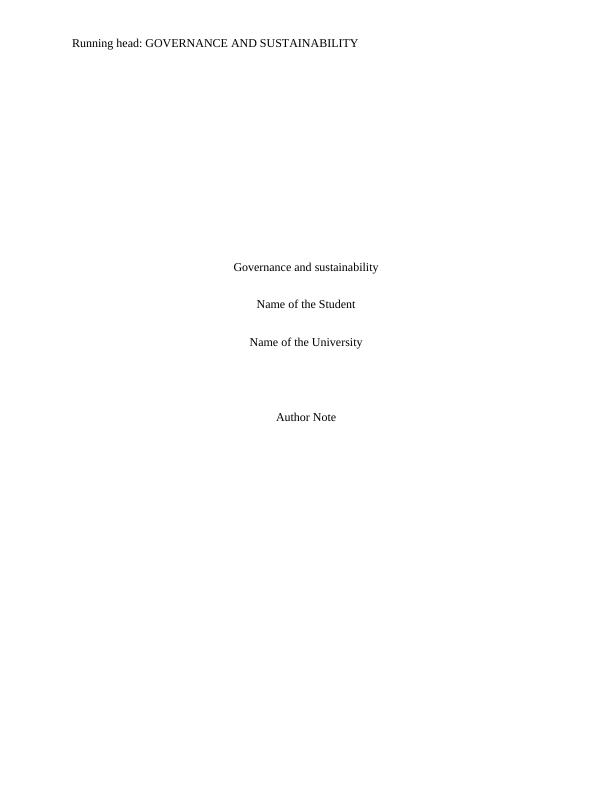
1GOVERNANCE AND SUSTAINABILITY
Table of Contents
Answer 1..........................................................................................................................................2
1.1 Green Economy.........................................................................................................................2
1.2. Challenges faced regarding advancement of sustainability initiatives: South Africa..............3
1.3. Triple Bottom Line...................................................................................................................4
1.4. The Environmental, Social and Governance (ESG) triad.........................................................6
Answer 2..........................................................................................................................................9
2.1 Corporate governance and ethics in business organization.......................................................9
2.2 Hallmark of an effective integrity organizational strategy......................................................12
Answer 3........................................................................................................................................13
Carroll’s four-part definition of Corporate Social Responsibility (CSR)......................................13
Reference list.................................................................................................................................17
Table of Contents
Answer 1..........................................................................................................................................2
1.1 Green Economy.........................................................................................................................2
1.2. Challenges faced regarding advancement of sustainability initiatives: South Africa..............3
1.3. Triple Bottom Line...................................................................................................................4
1.4. The Environmental, Social and Governance (ESG) triad.........................................................6
Answer 2..........................................................................................................................................9
2.1 Corporate governance and ethics in business organization.......................................................9
2.2 Hallmark of an effective integrity organizational strategy......................................................12
Answer 3........................................................................................................................................13
Carroll’s four-part definition of Corporate Social Responsibility (CSR)......................................13
Reference list.................................................................................................................................17

2GOVERNANCE AND SUSTAINABILITY
Answer 1
1.1 Green Economy
Concept
A green economy is an environmental friendly, clean economy that aims at promoting
wealth, health and welfare of the society. A green economy relies on sustainable development,
which implies our economies must develop in a manner that is beneficial to the environment
ensuring social equity and social justice. Green economy is considered as an economy that
results in improved well-being of human and encourages social equity while reduces ecological
scarcities significantly (Ferrell and Fraedrich 2015). A green economy can be perceived as a
source to attain a flexible economy that ensures a better quality of life for all the human beings
within the green limits of the planet. A green economy can be perceived as a means to connect
the environmental, social and economic considerations of sustainable development in a manner,
which enables to achieve economic development for, long-term by investing in socially equitable
and environmentally friendly solutions.
Need for an advanced green economy
It has been 20 years since the first Rio Summit, and the world persists to face two
significant challenges, namely, addressing environmental pressures that were left unresolved and
expansion of economic opportunities, given the rapidly growing global population. Green growth
is the common solution for these two global challenges and it aims at exploiting the opportunities
to meet these two challenges (Clapp and Rowlands 2014). Green growth implies promoting
economic growth and development while ensuring that the natural assets are not affected and it
Answer 1
1.1 Green Economy
Concept
A green economy is an environmental friendly, clean economy that aims at promoting
wealth, health and welfare of the society. A green economy relies on sustainable development,
which implies our economies must develop in a manner that is beneficial to the environment
ensuring social equity and social justice. Green economy is considered as an economy that
results in improved well-being of human and encourages social equity while reduces ecological
scarcities significantly (Ferrell and Fraedrich 2015). A green economy can be perceived as a
source to attain a flexible economy that ensures a better quality of life for all the human beings
within the green limits of the planet. A green economy can be perceived as a means to connect
the environmental, social and economic considerations of sustainable development in a manner,
which enables to achieve economic development for, long-term by investing in socially equitable
and environmentally friendly solutions.
Need for an advanced green economy
It has been 20 years since the first Rio Summit, and the world persists to face two
significant challenges, namely, addressing environmental pressures that were left unresolved and
expansion of economic opportunities, given the rapidly growing global population. Green growth
is the common solution for these two global challenges and it aims at exploiting the opportunities
to meet these two challenges (Clapp and Rowlands 2014). Green growth implies promoting
economic growth and development while ensuring that the natural assets are not affected and it
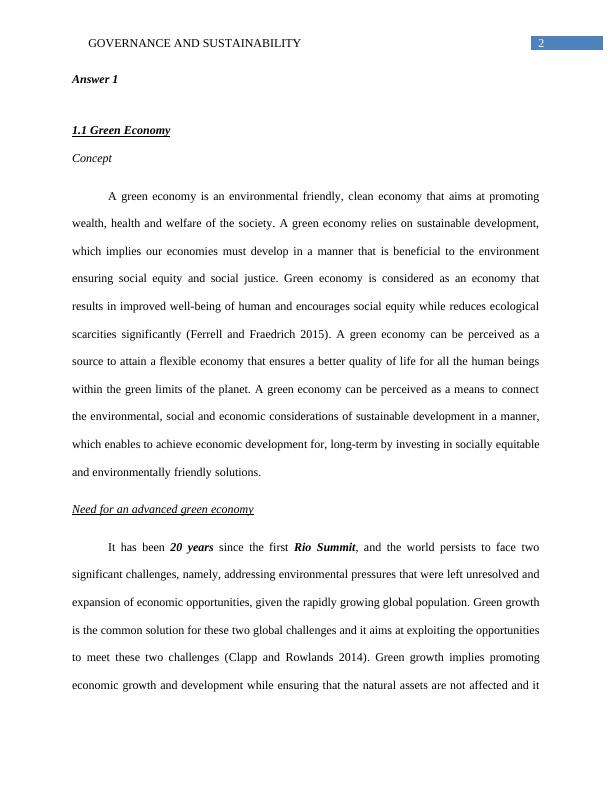
3GOVERNANCE AND SUSTAINABILITY
persist to endow the society and its participants with the environmental resources and services
for its welfare.
As Brown mentioned in the given article, events like sustainability week are essential to
advance and consolidate green economy as a sector by establishing a single market place. This
brings the buyers and sellers together in the market place where their ideas are carried forward
with the expectation that it would increase the number of sustainable projects (Wanner 2015).
Therefore, green growth shall provide a practical and flexible approach to ensure that natural
assets are able to deliver full economic potential sustainably where such potential shall include
provisions of clean water and air as well as the flexible biodiversity that is fundamental for food
production and human health.
1.2. Challenges faced regarding advancement of sustainability initiatives: South Africa
Although Africa is rich in natural resources, the development strategies adopted by the
continent have not been in agreement with the objectives of decent living conditions for the
inhabitants and maintaining high level of environmental quality. Due to political independence,
majority of the African countries have experienced serious environmental and socio-economic
crisis over the past decades (Christensen et al. 2015). Several development approaches and
theories have been adopted to enhance the living standards of the population without considering
the environment. However, most people in this contemporary era have questioned such
development approaches and strategies regarding its competency and adequacy in ensuring
higher living standards.
Sustainable development has been introduced as an alternative development strategy and
approach for improving the living standards of the human population without having an adverse
persist to endow the society and its participants with the environmental resources and services
for its welfare.
As Brown mentioned in the given article, events like sustainability week are essential to
advance and consolidate green economy as a sector by establishing a single market place. This
brings the buyers and sellers together in the market place where their ideas are carried forward
with the expectation that it would increase the number of sustainable projects (Wanner 2015).
Therefore, green growth shall provide a practical and flexible approach to ensure that natural
assets are able to deliver full economic potential sustainably where such potential shall include
provisions of clean water and air as well as the flexible biodiversity that is fundamental for food
production and human health.
1.2. Challenges faced regarding advancement of sustainability initiatives: South Africa
Although Africa is rich in natural resources, the development strategies adopted by the
continent have not been in agreement with the objectives of decent living conditions for the
inhabitants and maintaining high level of environmental quality. Due to political independence,
majority of the African countries have experienced serious environmental and socio-economic
crisis over the past decades (Christensen et al. 2015). Several development approaches and
theories have been adopted to enhance the living standards of the population without considering
the environment. However, most people in this contemporary era have questioned such
development approaches and strategies regarding its competency and adequacy in ensuring
higher living standards.
Sustainable development has been introduced as an alternative development strategy and
approach for improving the living standards of the human population without having an adverse
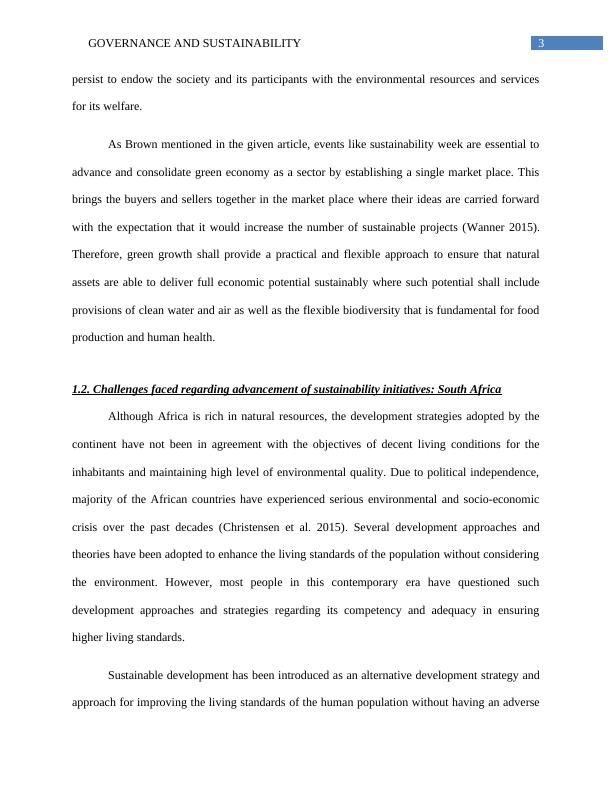
4GOVERNANCE AND SUSTAINABILITY
impact on the environment. The concept emerged from the realization that economic
environment and development are closely associated. The environmental issues arising in Africa
impedes the economic developments in Africa such as lack of broad-based development, high
reliability on primary commodities, land degradation, high population growth and degradation or
deforestation, etc.
The incline in high population in Africa is considered as a significant problem in the
continent as such incline in population rate is one of the primary reasons to cause poverty in
South Africa. Further, overpopulation has led to land degradation in the country due to the
processes, which results in low productive and quality capacity of such land. The degradation of
land results in deforestation, wildlife depletion, soil erosion, pollution, urban land degradation,
coastal degradation and desertification (Tricker and Tricker 2015).
For instance, the land-population resource relationship in Ghana demonstrates three
essential elements that influences the rate of land degradation, namely, land use systems, present
levels of infrastructure, present of technology that causes pressure on the land, giving rise to land
degradation. Due to the inappropriateness and effectiveness of the developmental strategies that
was existing in the country, new development strategies have been prepared to resolve the
developmental issues to ensure improvement in the living conditions of people all over the
world.
1.3. Triple Bottom Line
The Triple Bottom Line approach is considered as one of the method that is used to
determine profits that the organizations earn through their corporate sustainability solutions. The
use of triple bottom line approach is marked as one of the best methods that a business
impact on the environment. The concept emerged from the realization that economic
environment and development are closely associated. The environmental issues arising in Africa
impedes the economic developments in Africa such as lack of broad-based development, high
reliability on primary commodities, land degradation, high population growth and degradation or
deforestation, etc.
The incline in high population in Africa is considered as a significant problem in the
continent as such incline in population rate is one of the primary reasons to cause poverty in
South Africa. Further, overpopulation has led to land degradation in the country due to the
processes, which results in low productive and quality capacity of such land. The degradation of
land results in deforestation, wildlife depletion, soil erosion, pollution, urban land degradation,
coastal degradation and desertification (Tricker and Tricker 2015).
For instance, the land-population resource relationship in Ghana demonstrates three
essential elements that influences the rate of land degradation, namely, land use systems, present
levels of infrastructure, present of technology that causes pressure on the land, giving rise to land
degradation. Due to the inappropriateness and effectiveness of the developmental strategies that
was existing in the country, new development strategies have been prepared to resolve the
developmental issues to ensure improvement in the living conditions of people all over the
world.
1.3. Triple Bottom Line
The Triple Bottom Line approach is considered as one of the method that is used to
determine profits that the organizations earn through their corporate sustainability solutions. The
use of triple bottom line approach is marked as one of the best methods that a business
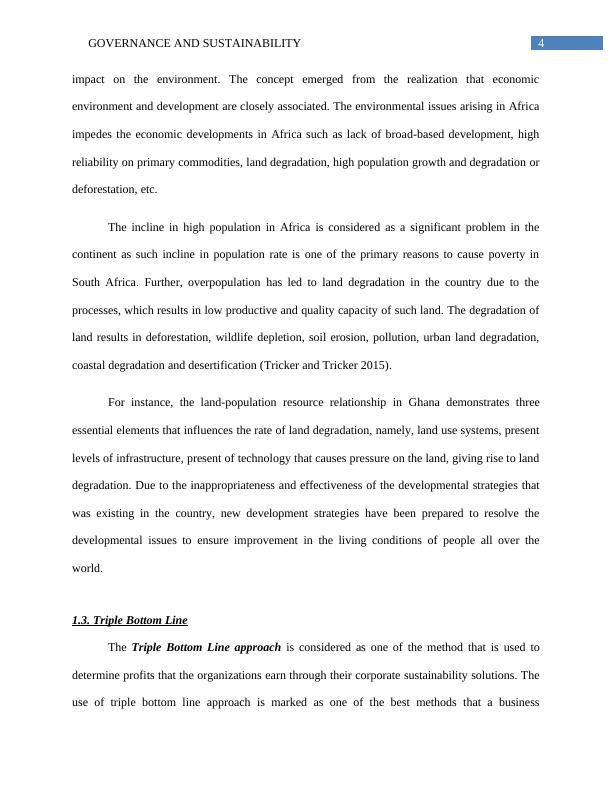
5GOVERNANCE AND SUSTAINABILITY
organization can use to determine how much profit the company is earning environmentally,
economically and socially.
The social bottom line assesses the profit earned by the business in terms of human
capital including the position of the business in the local society within which it carries out its
operations. The social bottom line is said to increase with corporate community engagement and
having beneficial and fair labor practices. This is because if the business of an organization is not
being able to form positive relationship with the community within which it carries out its
activities, it may lead to reduction in the employee and the customer base of the organization.
The social bottom line disregard the belief that the less a business pays to its workforce the
longer it can operate, the social bottom line approach enables an organization to assess the long-
term sustainability of the business human capital. It believes that if a business, which is also a
good and effective workplace, shall operate into the future, as there will be workforce who
would ensure that they remain a part of such business.
The economic sustainability in the Triple bottom line can be assessed in terms of the
impact the business of an organization has on the economic environment of such business. The
business that fortifies its economy shall be successful to carry out its operations in the future, as
the company shall be contributing to the economic health of its community and all its support
networks.
The Triple Bottom Line approach towards environmental sustainability refers to the fact
that the business operations of any organization can be carried out for longer period, if the
business has less impact on the environment as it would imply that the business would consume
fewer natural resources. To exercise control over the environmental bottom line would imply
organization can use to determine how much profit the company is earning environmentally,
economically and socially.
The social bottom line assesses the profit earned by the business in terms of human
capital including the position of the business in the local society within which it carries out its
operations. The social bottom line is said to increase with corporate community engagement and
having beneficial and fair labor practices. This is because if the business of an organization is not
being able to form positive relationship with the community within which it carries out its
activities, it may lead to reduction in the employee and the customer base of the organization.
The social bottom line disregard the belief that the less a business pays to its workforce the
longer it can operate, the social bottom line approach enables an organization to assess the long-
term sustainability of the business human capital. It believes that if a business, which is also a
good and effective workplace, shall operate into the future, as there will be workforce who
would ensure that they remain a part of such business.
The economic sustainability in the Triple bottom line can be assessed in terms of the
impact the business of an organization has on the economic environment of such business. The
business that fortifies its economy shall be successful to carry out its operations in the future, as
the company shall be contributing to the economic health of its community and all its support
networks.
The Triple Bottom Line approach towards environmental sustainability refers to the fact
that the business operations of any organization can be carried out for longer period, if the
business has less impact on the environment as it would imply that the business would consume
fewer natural resources. To exercise control over the environmental bottom line would imply
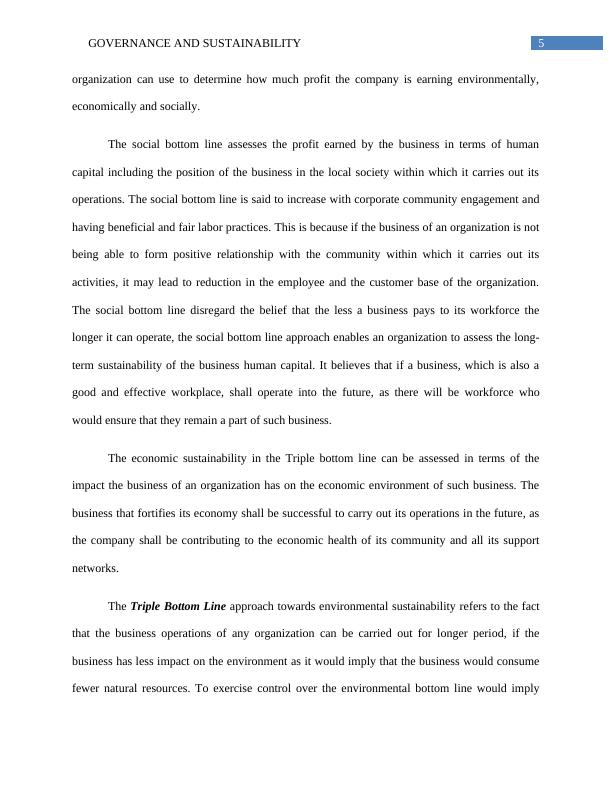
End of preview
Want to access all the pages? Upload your documents or become a member.
Related Documents
Green Economy and Sustainable Development Strategies in South Africalg...
|6
|1557
|249
Strategies for Sustainable Development in Circular Economylg...
|15
|5494
|465
ENGT5219 Engineering Business Environmentlg...
|11
|2789
|117
Green Marketing for Coffee: Sustainability Issues, Societal Influences, and Brand Analysislg...
|14
|2946
|393
Through valuing goods and serviceslg...
|2
|441
|16
Global Business Environment: Challenges and Recommendations for SASOLlg...
|13
|3027
|111
